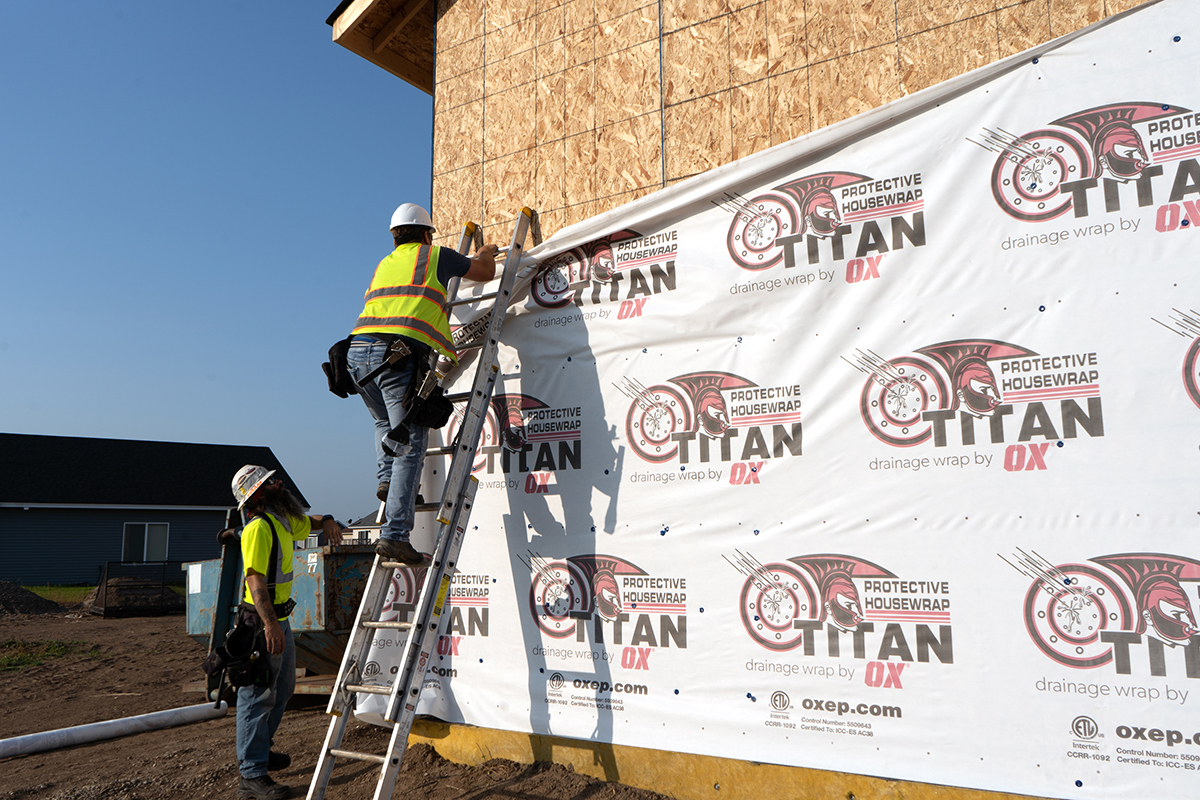It’s thin, tough, and more important than it looks.
It’s housewrap – one of the most critical components in a wall system. Nail the installation, and you’ll keep the elements out without a problem. Miss the mark, and you’ll be dealing with leaks and drafts for the life of the structure until it is fixed.
Installed behind the exterior cladding, housewrap acts as a weather-resistant barrier, designed to prevent water intrusion while still allowing moisture vapor to escape from the wall assembly.
But while housewrap is a commonly used material in modern construction, it is not always used correctly. From poor installation techniques to choosing the wrong type for climate or application, even small missteps can lead to big problems, including trapped moisture, air leaks, failed inspections, and costly callbacks.
Understanding and avoiding common mistakes can make all the difference in long-term performance and durability.
1.) Incorrect Overlapping and Sealing
One of the most common mistakes when installing housewrap is failing to maintain proper overlap and sealing at all seams. To function effectively, housewrap needs to be installed with each layer overlapping the one below it to shed water properly.
Inconsistent horizontal or vertical overlaps, skipped taping of seams, or using the wrong tape altogether can create gaps that allow air and moisture infiltration. Over time, this can compromise the building envelope, reduce energy efficiency, and even lead to mold and rot inside the walls.
These issues often stem from rushed installation, jobsite variability, or lack of training, but the consequences can be costly. Proper installation is the best way to avoid warranty claims or expensive repairs, and it is the key to long term performance and structural longevity.
2.) Puncturing the Barrier During Installation
A common but often overlooked mistake when installing housewrap is unintentionally puncturing or damaging the material during construction. If workers use improper or rushed installation techniques – stapling too aggressively, driving fasteners through the wrap, or accidentally tearing the housewrap while installing siding, flashing or windows – the housewrap can be punctured.
Housewrap is designed to act as a continuous weather-resistant barrier, protecting the wall assembly from environmental elements. Even small punctures or rips can compromise the integrity of the air and moisture barrier, allowing water to seep in and air to escape. This error can also lead to mold growth, reduced energy efficiency, and eventually structural damage.
3.) Harsh Climates
Harsh climates can test the limits of traditional housewrap materials. Whether it is extreme heat, heavy rain, high humidity, snow, or wind, housewrap can degrade, tear, or lose its effectiveness over time.
Intense UV exposure during extended construction delays can also weaken the wrap before the siding is even installed. Additionally, in cold climates, moisture that gets trapped in the wall assembly can freeze and expand, potentially leading to structural issues or mold growth.
When housewrap fails under these harsh weather conditions, the building envelope becomes vulnerable. Water can then seep in, and become trapped behind the cladding, which can lead to uncontrolled air leakage. This causes the heating and cooling systems to work harder, resulting in higher energy costs and reduced occupant comfort.
That is why products like HomeGuard® housewrap from OX Engineered Products are key to avoiding damage from harsh weather. Made from cross-woven polyolefin, HomeGuard offers high tear strength, resists UV degradation, and does not easily rip or sag during installation or under harsh weather conditions.
4.) Not Integrating with Other Building Envelope Components
One of the most common mistakes is failing to properly integrate housewrap with other key building envelope components such as windows, doors, flashing, and roofing elements.
The building envelope is only as strong as its weakest link. Housewrap is designed to work in concert with other materials to create a continuous air and moisture barrier. If it is not correctly layered and sealed at transitions between different exterior materials, weak points form, allowing air and water to enter the wall assembly.
5.) Using the Wrong Product for the Application
Not all housewraps are created equal. Performance specs can vary to accommodate unique water and air resistance and durability requirements depending on the application. If the wrong housewrap product is selected, it may not perform as intended. It might tear under wind load, degrade under prolonged UV exposure, or fail to prevent moisture intrusion in high-humidity or cold climates.
Know your climate. Understand the code requirements. Choose the right material for that particular job.
Get It Right the First Time: Avoid Callbacks and Costly Repairs
Avoiding common housewrap mistakes starts with understanding how critical the material is to the health of a building envelope. From choosing the right product to ensuring proper installation and integration, every detail counts.
Take the time to get it right. Reduce the risk of costly callbacks. Improve energy efficiency. And most importantly, protect the long-term integrity of the structures you build.
Don’t underestimate housewrap. It’s not just another layer. It is a crucial line of defense for the entire building envelope.

